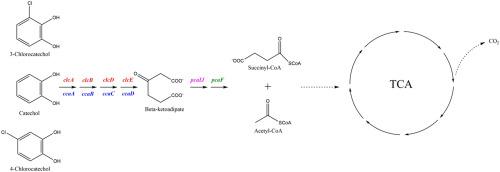Journal of Hazardous Materials ( IF 12.2 ) Pub Date : 2021-06-18 , DOI: 10.1016/j.jhazmat.2021.126428 Bo Wang 1 , Jianjie Gao 1 , Jing Xu 1 , Xiaoyan Fu 1 , Hongjuan Han 1 , Zhenjun Li 1 , Lijuan Wang 1 , Fujian Zhang 1 , Yongsheng Tian 1 , Rihe Peng 1 , Quanhong Yao 1

|
Chlorinated aromatic compounds are a serious environmental concern because of their widespread occurrence throughout the environment. Although several microorganisms have evolved to gain the ability to degrade chlorinated aromatic compounds and use them as carbon sources, they still cannot meet the diverse needs of pollution remediation. In this study, the degradation pathways for 3-chlorocatechol (3CC) and 4-chlorocatechol (4CC) were successfully reconstructed by the optimization, synthesis, and assembly of functional genes from different strains. The addition of a 13C-labeled substrate and functional analysis of different metabolic modules confirmed that the genetically engineered strains can metabolize chlorocatechol similar to naturally degrading strains. The strain containing either of these artificial pathways can degrade catechol, 3CC, and 4CC completely, although differences in the degradation efficiency may be noted. Proteomic analysis and scanning electron microscopy observation showed that 3CC and 4CC have toxic effects on Escherichia coli, but the engineered bacteria can significantly eliminate these inhibitory effects. As core metabolic pathways for the degradation of chloroaromatics, the two chlorocatechol degradation pathways constructed in this study can be used to construct pollution remediation-engineered bacteria, and the related technologies may be applied to construct complete degradation pathways for complex organic hazardous materials.
中文翻译:

大肠杆菌中 3-氯邻苯二酚和 4-氯邻苯二酚两条新的完全降解途径的优化和重建
氯化芳族化合物因其在整个环境中广泛存在而成为严重的环境问题。虽然一些微生物已经进化获得了降解氯化芳族化合物的能力并将其用作碳源,但它们仍然不能满足污染修复的多样化需求。在本研究中,通过优化、合成和组装不同菌株的功能基因,成功重建了 3-氯儿茶酚 (3CC) 和 4-氯儿茶酚 (4CC) 的降解途径。增加一个13C-标记的底物和不同代谢模块的功能分析证实,基因工程菌株可以与自然降解菌株类似地代谢氯儿茶酚。尽管可能会注意到降解效率的差异,但包含这些人工途径之一的菌株可以完全降解儿茶酚、3CC 和 4CC。蛋白质组学分析和扫描电镜观察表明3CC和4CC对大肠杆菌有毒性作用,但工程细菌可以显着消除这些抑制作用。作为氯代芳烃降解的核心代谢途径,本研究构建的两条氯代儿茶酚降解途径可用于构建污染修复工程菌,并应用相关技术构建复杂有机有害物质的完整降解途径。











































 京公网安备 11010802027423号
京公网安备 11010802027423号